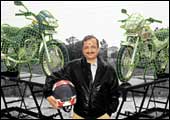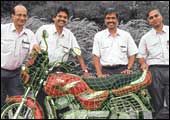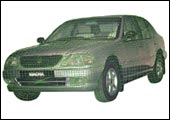|
Until
recently, if an Indian automotive company wanted to launch a new
vehicle, it had two options: One, and this was the practice for
most of the industry's sixty-year history in India, it would turn
to its technology partner, and pick up a near-obsolete model dirt
cheap. Two, this was rare, it would go to a design centre-say, in
Turin, Italy-and pay a hefty sum. This is what Tata Engineering
did when it forayed into passenger cars with its Indica in 1999.
Circa 2002, a third option is being tried out
by a bunch of manufacturers: that of designing and developing vehicles
on their own. And guess what? They are more than just succeeding.
Mahindra & Mahindra's sports utility vehicle (SUV), Scorpio,
was conceived and developed by its own engineers in Nasik. Tata
Engineering's mid-sized sedan, code-named Magna and due for launch
around 2004, has been designed in-house. Two-wheeler company TVS
Motor turned to its own product development team for the launch
of Victor. Bajaj Auto, despite a partnership with Kawasaki, decided
to build its dandy motorbike Pulsar without much external help.
And so have Royal Enfield (Thunderbird) and LML (Freedom).
So, just what is making it possible for these
companies to home-grow vehicles? "Advancement in design technology
and the global exposure of Indian auto executives," says Deepak
Singhania, Managing Director, LML. The biggest driver is, of course,
competition. In passenger cars, the benchmark is truly global, given
that there is only one serious domestic player. In motorcycles,
snazzy styling is at once a differentiator and brand-booster. Says
Pradyumna Vyas, Chairman (Industry Programmes and Projects), National
Institute of Design, Ahmedabad: "Some companies have acquired
design capabilities and are leveraging that to differentiate themselves."
There is one big advantage of doing so: Cost.
Tata Engineering's Magna will end up costing between Rs 300 crore
and Rs 600 crore-a similar effort at, say, General Motors, would
have cost upwards of $1 billion (Rs 4,900 crore). LML spent a bare
Rs 75 crore on Freedom. Had the company outsourced design, the bill
would have been twice that. Says Pawan Goenka, Executive VP (Product
Development), M&M: "The cost of skilled manpower in India
is just a fifth compared to the rest of the world." Some experts
believe that sometime soon in the future, India could become a back-office
for automotive design work. But that's another story.
M&M's Scorpio: The Art of Possible
Despite incredible odds, a young team managed
to build India's first SUV.
 |
| Behind the Scorpio: (L to R) P.K. Goenka,
M.V. Raman, Vikas Bawa |
Quite simply, Mahindra
and Mahindra's Scorpio is India's biggest design story of the new
millennium. Not since Tata Engineering's Indica has any vehicle
generated so much excitement and chest-thumping as the snazzy Scorpio.
And justifiably so. For, the Scorpio almost didn't happen. When
the idea of a smart, new-age sports utility vehicle was first proposed
by m&m's President (Automotive Division), Alan Durante, in 1996,
the company's Vice Chairman and Managing Director, Anand Mahindra,
merely asked his team to explore the feasibility of the project.
And when it did seem possible to build an SUV in India, Mahindra
stepped in with a caveat: there would be no big money to spend on
it.
With some initial help from Ford Motor Co.,
M&M's Integrated Design and Manufacturing (IDAM) team in Kandivali,
Mumbai, set about finding ways of building a world-class vehicle
at local costs. Making a clean break from its past, M&M first
decided to ask its customers what kind of an SUV they wanted. The
rationale was simple. Says Pawan Goenka, Vice President (Product
Development), who spent 15 years with General Motors in Detroit
before joining M&M: "It's easier to make what you can sell
than to sell what you have made"-a phrase that became the team's
mantra. The product development team-just 120-big and with a ridiculously
low average age of 27-was broken up into 19 cross-functional teams,
each with a leader responsible for decision-making and targets.
Concurrent engineering allowed the design team to work with vendors
closely and, therefore, significantly cut down on development time
and rework. Although a lot of the design work was spread over the
US, Korea, Japan, France, Austria and the UK, Kandivali was the
nerve centre. At every stage of the development, customer feedback
would be incorporated to ensure the vehicle came as close as possible
to market expectations. That's one reason why despite importing
the petrol engine from Renault (the diesel version was developed
inhouse with help from AVL, Austria) and the suspension system from
Samlip (Korea), M&M was able to price the Scorpio between Rs
5.5 lakh and Rs 6.35 lakh. Emboldened by the success of its Rs 600-crore
project, M&M has started work on new vehicles, besides new variants
of the Scorpio. That may just turn around the company's declining
fortunes in the automotive industry.
-Abir Pal
Bajaj's Pulsar: Easy Rider
It's got all the bells and whistles,
and more.
 |
| Pulsar pride: R.L. Ravichandran, VP,
Bajaj Auto |
Pulsar was conceived
in late 1997 by Rahul Bajaj, chairman, Bajaj Auto, and a team of
top executives. The idea was to offer a performance motorcycle for
bike enthusiasts, and one that would be relevant at least for the
next five years of its launch. Much like LML, the company was experiencing
a shift away from scooters and fuel-guzzling two-stroke bikes. And
it had to quickly build up a portfolio of motorcycles that were
not only fuel-efficient, but would be able to rope in young consumers
through contemporary styles. By the end of 1998, the company made
a mid-course correction and decided to offer the bike in two engine
capacities-150cc and 180cc. Designing started immediately and barely
17 months later, the pilot bike was ready. What made the performance
even more impressive was the fact that the Pulsar had completely
new engines and chassis, a five-speed gear box, counterbalance,
disc brakes, and a starter motor. The entire design and development,
says R.L. Ravichandran, Vice President (Business Development &
Marketing), was handled by Bajaj Auto's 19-member engineering team,
with a relatively low average age of 29. The company won't reveal
the exact amount of money spent on developing Pulsar, but says it
has invested Rs 100 crore in R&D costs over the last three years.
BT understands that half of that may have gone into Pulsar alone.
Since its launch in November 2001, Pulsar has sold 50,000 units.
-Abir Pal
LMl's Freedom: Turnaround
Vehicle
The company's future rides on it.
 |
| Freedom to ride: Deepak Singhania, MD,
LML |
Imagine having
to reinvent your company. LML's Deepak Singhania doesn't have to.
He's done it already. Until three years ago, LML was a scooter manufacturer
with Piaggio as a partner. Then, Piaggio left and the two-wheeler
market moved away from scooters to motorcycles. Over the past 24
months, Singhania has fought back with new motorcycle models, with
help from Daelim of Korea and 150 engineers at LML's new design
centre in Kanpur. LML's first two motorcycle offerings, Adreno and
Energy, were part-imported from Daelim and niche products. But LML
needed a bike that would generate volumes. As an answer, Freedom
was conceived in May last year. The 110-cc Freedom also draws its
platform from Daelim, but LML has given it a new look and feel.
Ergo, the computer designing, prototype machining and testing was
carried out by LML's team.
An all-aluminium, low-friction engine and internal
oil transfer system today form Freedom's USP. "Freedom is a
bike that conforms to global standards of engineering and design,"
says Singhania. Freedom promises a fuel consumption of 85 km per
litre. Since its launch in Uttar Pradesh on July 15, 2002, Freedom
has sold over 2,500 units. By the end of the year, that figure is
likely to hit 80,000. If it does, Singhania may be back in the two-wheeler
game with a bang.
TVS' Victor: One Of Its
Kind
How the company learnt to go solo.
 |
| Victor(ious): (L to R) Y.R. Babu, R.
Sundaresan, Vinay H. Chandrakanth, R. Venkatesan |
When TVS motor's
design team started work on its 110-cc Victor in the end of 1999,
it faced two major challenges. One, it had been asked to design
a motorbike with the power of a two-stroke, but the fuel efficiency
of a four-stroke engine. Two, that seemingly impossible task had
to be done without any help from its soon-to-part Japanese ally,
Suzuki Motor Company. Fortunately, though, it wasn't the first big
design project for the team. A year earlier it had launched TVS
Spectra-a 150-cc scooter, built from scratch at its Mysore plant.
To marry power with fuel efficiency, the team came up with an innovative
solution: a microprocessor-controlled power mode ignition system,
which automatically makes the choice between power and fuel efficiency.
When tests revealed that the rider tended to
develop a backache after long hauls, the TVS engineers came up a
three-level suspension system, besides optimising the seat foam
characteristics. The interesting point, however, is that the design
team actually shaved costs by some 20 per cent, while making these
improvements. The company estimates that its product development
cost of Rs 70 crore would have been double had the design been outsourced
to a foreign firm.
The fact that TVS Victor has just 1 per cent
import content allows the company to price it at Rs 41,200 (ex-showroom,
Chennai) and take on Bajaj Caliber and Hero Honda Splendour.
-Nitya Varadarajan
Tata Magna: D Major
Luxury car making is a different ballgame.
 |
| Tata Magna: Indica's sequel? |
And that's probably
why eight years after it was first dreamed up, the Magna has just
about reached style freeze. And it may be next year before the car
hits the market. The Magna will be Tata Engineering's second passenger
car, but will be vastly different from Indica. Reason: the two segments
behave very differently. While the small car buyer is tolerant of
minor glitches, the luxury car buyer is a finish fanatic. When Tata
Engineering began work on Indica, there was just one brief from
group Chairman, Ratan Tata. It had to be a big car at the price
of a small car. And since it was the auto major's first foray into
passenger cars, it turned to I.D.E.A. of Italy for design help.
Three and a half years, Rs 1,700 crore in investment and some glitches
later, the Indica in its new v2 avatar has proved a runaway success.
The Magna, however, has been developed in house. Most of the work
has been done at the Pune plant, using cad systems and Mac-based
styling tools from Alias of the UK. The car was to debut in the
middle of 2002, but a rash of launches-Hyundai Sonata, Honda Accord,
Ford Mondeo and the Mercedes c-180-sent it back to the drawing board.
The Magna will have one huge advantage over its rivals. Since its
development cost is expected to be between Rs 300 crore and Rs 600
crore, Tata Engineering will be able to price it competitively and
break even faster on small volumes. Now, it's just a question of
getting the quality equation right.
-Abir Pal
Reva: The Unconventional
The car may actually be ahead of its time.
 |
| Eco-friendly duckling: Chetan (L) &
Sudarshan Maini with the Reva |
You'll probably
never get into a Reva, let alone own one. But you have to hand it
to Chetan Maini, Managing Director of Reva Electric Car Company.
He was the first carmaker in India to think, way back in 1994, of
a battery-operated people's car. In July last year, he actually
put it on the road. The car hasn't found too many takers (just 270
Revas have been sold), but consider the design challenges. For one,
the car had to be cheap enough to attract two-wheeler owners. It
also had to think around the problem of recharging stations. That
meant a lot of out-of-the-box thinking like the energy management
technology that allows the car to run 80 kms on a nine-hour charge,
or the 'space-frame' aerodynamics.
The initial work on Reva was done by Amerigon
in the US. After the prototype was made, the project was shifted
to India, where the rest of design, production engineering and testing
were done in RECC's Bangalore facilities. Since Maini wanted his
small car to be internationally relevant, A.T. Kearney was roped
in to spec out the product. Still, despite a price of Rs 2.54 lakh,
Reva hasn't been able to overcome consumer prejudices. A great idea,
but for another time.
-Venkatesha Babu
Enfield's Thunderbird
Two wheels on a shoestring.
 |
| Well-packed thunder: Siddhartha Lal,
CEO, Royal Enfield |
The month Siddhartha
Lal took over royal enfield as the chief executive, he ordered work
on a powerful bike with retro looks, but with an electronic ignition
and a five-speed gear box. Since the company operates in a miniscule
market and has annual sales of just 25,000 units, the design team
had to make do with a shockingly small budget of Rs 1 crore. To
pull off the near-impossible feat, the product team came up with
an innovative solution: vendors were asked to do the product design
for the component they were supplying.
For example, Chennai-based Iris Development
Engineering Limited designed the sheet metal body panels for Thunderbird;
plastic parts were taken care of by Central Institute of Plastic
Engineering and Technology in Chennai, and the instrument cluster
was designed by the Coimbatore-based supplier, Pricol. To lower
product cost, Royal Enfield decided to pull in components like the
ignition system and the gearbox from its existing models.
Using 3d visualisation and engineering software,
which allows rapid prototyping, the company's engineers at the Tirruvottiyur
studio crunched design time to just seven months. Although the Thunderbird
isn't a completely new platform and borrows from one-year-old Bullet
Electra, its body frame, engine, gearbox, and the retro looks are
completely new. It also sports an improved 350-cc engine. Lal reckons
that the bike, launched in Bangalore past April, would have cost
Rs 5 crore in a design studio abroad. Moral of the story: If you
are a niche player, innovate like hell.
|

